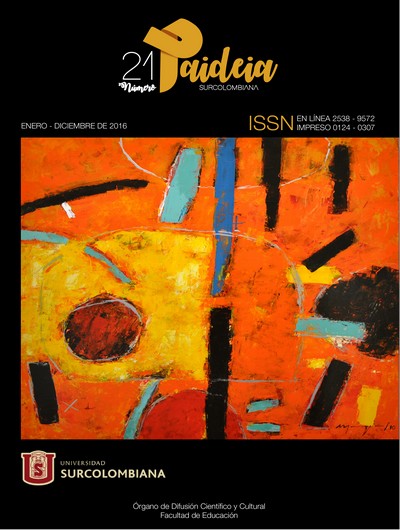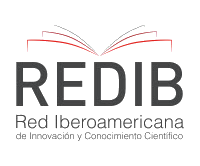The emotional competence in people with deafness
##plugins.themes.bootstrap3.article.main##
developing to turn a comparison with the students listener in regard to these competencies. It is also deepened in the need to develop these emotional skills in the school and in this collective especially, recalling that the harmonious development of every being is an intrinsic relationship with the field of emotion that conforms him.
Downloads
##plugins.themes.bootstrap3.article.details##
Bandura, A. (1977). Social learning theory. NJ: Prentice Hall.
Bar-on, R. (2006). The Bar-on model of emotional-social intelligence (ESI). Psicothema, 18(1), 13-25.
Benvenuto, A. (2009). El sordo y lo Inaudito. Uruguay: Educa. Recuperado el 16 de Noviembre del 2016, de:http://www.uruguayeduca.edu.uy/Userfiles/P0001/File/El%20sordo%20y%20lo%2 0inautito.doc
Boix, C. (2007). Educar para ser feliz. Una propuesta de Educación Emocional. Madrid. CEPE.
Cañizares, G. (2015). Alumnos con déficit auditivo. Un nuevo método de enseñanza- aprendizaje. Madrid. Narcea, S.A. de Ediciones.
Dammeyer, J. (2010). Psychosocial development in a Danish population of children with cochlear implants and deaf and hard-of-hearing children. Journal of Deaf Studies and Deaf Education, 15(1), 50-58.
Denham, S. A., Blair, K. A., DeMulder, E. D.,
Levitas, J., Sawyer, K., Auerbach-Major, S., Queenan, P. (2003). Preschool emotional competence: Pathway to social competence? Child Development, 74 (1), 238–256.
Díaz, E. (2013). El reflejo de la mujer en el espejo de la discapacidad. La conquista de los derechos sexuales y reproductivos de las mujeres con discapacidad. Madrid: Cinca Editorial. Recuperado el 2 de Noviembre del 2016, de: http://www.once.es/new/plan-de-igualdad/documentos-de interes/El%20reflejo%20de%20la%20mujer%20en%20el%20espejo.pdf
Farrugia, D., y Austin, G. (1982). A study of social-emotional adjustment patterns of hearing impaired students in different educational settings. American Annals of the Deaf 125, 535-41.
Fehr, B. J. y Exline, R. V. (1987). Social visual interactions: A conceptual and literature review. En A. W. Siegman & S. Feldstein (Eds.), Nonverbal behaviour and communication (Vol. 2nd, pp. 225-326). Hillsdale, NJ: Lawrence Erlbaum.
Flavell, J.H. (2004). Theory-of-Mind Development: Retrospect and Prospect. Merrill-Palmer Quarterly, July 2004, Vol. 50, No. 3, 274–290. 1.
Goleman, D. (2001) Inteligencia Emocional. Barcelona. Kairós. Gray, C., Hosie, J., Russell, P., Scott, C. Hunter, N. (2007). Attribution of emotions to story characters by severely and profoundly deaf children. Journal of Developmental and Physical Disabilities, 19 (2), 145-159.
Güell, M. Muñoz, J. (2000). Desconócete a ti mismo. Programa de alfabetización emocional. Barcelona. Paidos
Gutiérrez Fernández, A. (2007) El futuro de la educación del sordo. Y mientras, algunos retos, necesidades y demandas del presente. Psicología Educativa Vol. 13 (1) pp. 5-34. Recuperado el 5 de Noviembre del 2016, de: http://docplayer.es/22008086-Psicologia-educativa-2007-vol-13-n-o-1-pags-5-34-issn-1135-755.html
Hanafi, M., Yasin, M., Bari, S., Salubin, R. (2012). Emotional intelligence among deaf and hard of hearing children. Social Sciences, 7 (5), pp. 679-682.
Hintermair, M. (2007). Prevalence of socioemotional problems in deaf of hearing children in Germany. American Annals of the Deaf, 152 (3), 320-330.
Hogan, A., Shipley, M., Strazdins, L., Purcell, A., & Baker, E. (2011). Communication and behavioural disorders among children with hearing loss increases risk of mental health disorders. [Comparative Study]. Australian and New Zealand Journal of Public Health, 35(4), 377-383.
Keilmann, A., Limberger, A., y Mann, W.J. (2007). Psychological and physical well-being in hearing-impaired children. International Journal of Pediatric Otorhinolaryngology, 71 (11), pp.1747-1752.
Keltner, D. y Gross, J. (1999) Functional account of emotions. Cognition and Emotion Special Issue: Functional Account Of Emotion. 13(5) 467-480.
Ketelaar, L., Wiefferink, C.H., Frijins, J.H.M., Broekhof, E., Rieffe, C. (2015). Preliminary findings on associations between moral emotions and social behavior in young children with normal.
Quirin, M., & Lane, R. D. (2012). The construction of emotional experience requires the integration of implicit and explicit emotional processes. Behavioral and Brain Sciences, 35, 159-160.hearing and with cochlear implants. European Child and Adolescent Psychiatry, 24 (11), pp. 1369- 1380.
Li, Y., Bain, L., & Steinberg, A. G. (2003). Parental decision making and the choice of communication modality for the child who is deaf. [Comparative Study Research Support, Non-U.S. Gov't]. Archives of Pediatrics and Adolescent Medicine, 157(2), 160-168.
Lledo, A. (2008). La discapacidad auditiva. Un modelo de educación inclusiva. Madrid. Edebe
Lori, H. (2014). Social-Emotional Development in Children with Hearing Loss. Theses and Dissertations—Communication Sciences and Disorders. Paper 4. Recuperado el 2 de Enero del 2017 de: http://uknowledge.uky.edu/commdisorders_etds/4
Molina, L., Ipiña, M., Reyna, C. y Guzmán, R. (2011). Competencia social en niños con sordera profunda. Revista CES Psicología, 4, 1-14.
Muñoz, J. (2006). Sordera y salud mental: la psicología frente a la deficiencia auditiva. Infocop On/ine.
Pabón, S. (2009). La discapacidad auditiva. ¿Cómo es el niño sordo?. Revista internacional de innovación y experiencias educativas, 16 (305), 1-10.
Peterson, C. y Siegal, M. (2000). Insights into Theory of Mind from Deafness and Autism. Mind & Language, 15: 123–145.
Pigliacampo, R. (2007). Parole nel movimento. Psicolinguistica del sordo. Italia. Armando Editore.
Pineda, P. (2015). Niños con capacidades especiales. Madrid. Hércules Ediciones.
Pourmohamadreza, M., Ashori, M., & Jalilabkenar, S. (2013). The Effectiveness of emotional intelligence training on the mental health of male deaf students. Iranian journal of public health, 42(10), 1174.
Ramos, N., Recondo, O. y Henríquez, H. (2012) Practica la Inteligencia Emocional Plena: la gestión eficaz de las emociones a través de mindfulness. Barcelona. Kairós.
Rieffe, C. (2012). Awareness and regulation of emotions in deaf children. British Journal of Developmental Psychology, 30(4), 477-492.
Rieffe, C., Terwogt, M., and Jellesma, F. (2008). Emotional competence and health in children. Emotion regulation, 184-201.
Riso, W. (2012). Sabiduría emocional. Un reencuentro con las fuentes naturales del bienestar y la salud emocional. Nápoles. Océano.
Schutte, N.S., Malouff, J.M., Thorsteinsson, E.B., Bhullar, N., Rooke, S.E. (2007). Personality and individual differences, 42 (6), 921-933.
Sidera, F., Amadó, A. y Martínez, L. (2016) Influences on Facial Emotion Recognition in Deaf Children. Journal of Deaf Studies and Deaf Education, 1–14.
Simón, M. (2007). Educación y desarrollo socioemocional en los niños sordos. Ríos. Educa
Svirsky, M. A., Robbins, A. M., Kirk, K. I., Pisoni, D. B., & Miyamoto, R. T. (2000). Language development in profoundly deaf children with cochlear implants. [Research Support, U.S. Gov't, P.H.S.]. Psychological Science, 11(2), 153-158.
Tharpe, A. M. (2008). Unilateral and mild bilateral hearing loss in children: Past and current perspectives. [Historical Article Research Support, Non-U.S. Gov't Research Support, U.S. Gov't, Non-P.H.S. Review]. Trends Amplif, 12(1), 7-15.
Valmaseda, M. (2004). El desarrollo socio-emocional de los niños sordos. Intervención desde la escuela. En A.B. Domínguez y P. Alonso (Eds.) La educación de los alumnos sordos hoy. Perspectivas y respuestas educativas. Málaga: Aljibe.
Valmaseda, M. y Gómez, L. (1999). La intervención educativa con los alumnos sordos. En J.N. García Sánchez (Coord.). Intervención psicopedagógica en los trastornos del desarrollo. Madrid: Pirámide
Vogel-Walcutt, J.J., Schatschneider, C., Bowers, C. (2011). Social-Emotional Functioning of Elementary-Age Deaf Children: A Profile Analysis. American Annals of the Deaf, 156 (1), 6-22.
Wiefferink, C.H., Rieffe, C., Ketelaar, L., Frijins, J.H. (2012). Predicting social functioning in children with a cochlear implant and in normal-hearing children: The role of emotion regulation. Internacional Journal of Pediatric Otorhinolaryngology, 76 (6), 883-889.
Yoshinaga-Itano, C., Baca, R. L., & Sedey, A. L. (2010). Describing the trajectory of language development in the presence of severe-to-profound hearing loss: A closer look at children with cochlear implants versus hearing aids. Otology & Neurotology, 31(8), 1268-1274.
Ziv, M., Most. T., Cohen, S. (2013). Understanding of emotions and false beliefs among hearing children versus deaf children. Journal of Deaf Studies and Deaf Education, 18 (2), 161-174.














